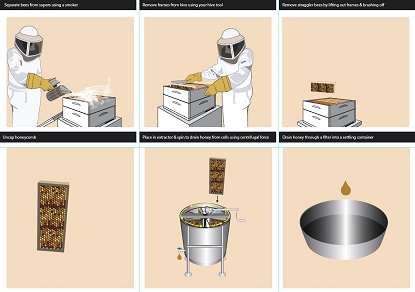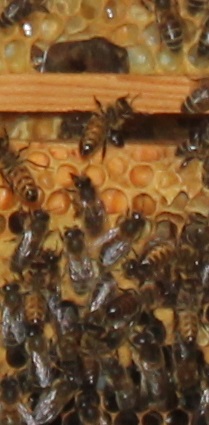 When keeping bees, it pays to check on the hives to see how they are going.
When keeping bees, it pays to check on the hives to see how they are going.
Timing is important for harvesting honey and beeswax; and any other products from the hive (eg. propalis).
Collecting and Processing Honey
When you see that the frames are about 3/4 capped it is time to extract. Fresh honey contains a considerable amount of water, and when extracted green it may ferment. When you are out near your hives at night and you can hear humming, don't worry, the bees are curing the honey (evaporating excess moisture from the nectar).
Make sure that you are wearing your protective suit, correct gloves, and have your tools handy:
- Your smoker.
- A wire mesh queen excluder – this allows worker bees through but not the queen
- A hive tool (for removing frames with the loaded honeycombs).
- A super frame to hold the collected frames.
There are many ways to remove the bees from the honey supers ranging from blowers to chemical mats. Providing you have a queen excluder, robbing is a simple matter. Put a little smoke over the top box and take each tray out one at a time. Give each frame one or two sharp downward shakes to dislodge most of the bees and then a quick brush with a bee brush will remove the rest. Don't leave your hive without a honey super for long otherwise the bees will start to fill the brood chamber with honey.
Uncapping
- You need a pot of boiling water on the stove and a couple of sharp long-bladed knives. Hold the frame on its end and with the heated knife, cut from the top down with a sawing motion that will cut more evenly.
- An uncapping fork will help you to unseal the honey cells that you couldn’t open with the heated knife.
- For those who can't afford a small two frame extractor, a 'slinger' which is a hand-operated single frame extractor, would be a cheaper alternative. The top bar of the comb goes to the outside as the cells slope upwards.
- A plastic food grade tub or bucket to collect the honey from the frames (if done by hand) or from the extractor.
- A fine kitchen strainer or sieve is ideal to strain the honey, although a double sieve is also often used to make sure all impurities are removed.
Hints:
- In winter, honey is cold and is very hard to extract; it also candies readily. If you want to return the honey to its normal consistency either leave it in the sun for a while, or warm it lightly.
- Always seal your honey because it attracts moisture.
- Honey containers with plastic caps are easy to use and are readily available in various sizes from small 25ml jars to small 1litre buckets, from beekeeping suppliers.
- Make sure that you seal jars as soon as possible after filling with honey – honey is hygroscopic it absorbs air moisture – unsealed jars left in open and humid conditions may start to ferment when exposed to excessive moisture.

Collecting and Processing Beeswax
When bees collect pollen and nectar from flowers and bring it back to the hive – some of it is converted into honey but the rest is converted into beeswax. Bees build their combs from beeswax so they need it in order to survive.
Once you see white cappings in the hive covering the hexagonal shaped cells, it means that the honey is ready for extraction. It is the cappings which are situated on both sides of the cells that make up the beeswax.
The cappings are removed from both sides of the cells and set aside to max wax blocks and the honey is then readily extracted from the cells.
 Bees wax is great for making:
Bees wax is great for making:
- Candles
- Furniture polishes
- Leather polish
- Wax printing on cloth
- Waterproofing thread
- Hoof conditioners for animals
Combs may be rendered into wax blocks – newer combs produce the best quality wax. Older combs contain propolis and also waste residue such as old cocoons – this makes it a less desirable wax.
Interesting fact: Bees’ wax has a high melting point when compared to other types of wax 64 degrees C.
Most methods of rendering wax use hot water to melt it. They are based on the fact that beeswax floats in water. A few words of caution are in order, however:
- Place the honey comb into a large, steel, aluminium or enamelled pot filled with cold water.
- Place it on a stove and heat the water until the wax is melted – DO NOT boil the water vigorously as the wax is flammable; vigorous boiling also produces a brittle, lower quality wax.
- Strain the wax and water through a screen into another container.
- When the water cools the wax will harden on top of the water.
- Remove the wax.
- There will be some residue on the bottom of the wax – scrape this off until you reach clean wax.
- Store the wax blocks in sealed (e.g. snap-lock) plastic bags.
- You can reheat the wax and use it as desired e.g. pour it into mould etc.
Hints:
- Render the combs into blocks as soon as possible after honey extraction – as the combs age they are susceptible to damage by wax moths.
- Store un-rendered combs in sealed plastic bags along with moth balls and check often to ensure there is no deterioration from moth larvae.
- Bees wax will absorb chemicals – keep away from pesticides etc. has they can contaminate the wax and it will be no longer useful as a comb foundation.
- Always use steel, aluminium or enameled containers when processing bees wax other metals e.g. copper may discolour the wax.